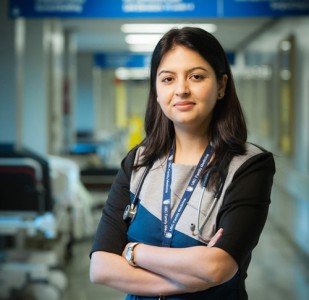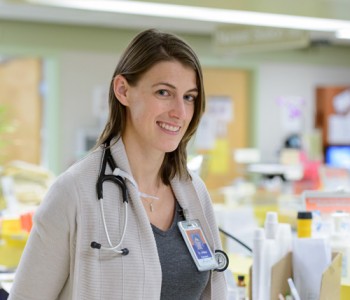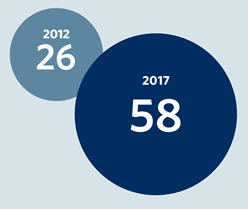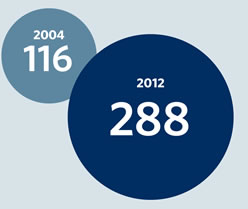[From the December 2012 issue of UBC Reports]
Kirti Aneja was proud of her achievements when she began practising as an anesthesiologist in a rural community in India’s northern state of Punjab in 2007.
She’d wanted to be a doctor since she was a little girl playing with toy medical kits and was inspired by childhood visits to leprosy hospitals. She was happily married to her medical school sweetheart and expecting their first–born son.
But her family made a gut-wrenching decision: to leave their beloved homeland to pursue a better life for their children. And her passion to use her medical skills turned to serving people in her new country, Canada.
Dr. Aneja is an international medical graduate (IMG), one of a group of permanent residents or Canadian citizens trained outside of North America who are seeking to practise medicine in Canada.
The B.C. government has committed to increasing funding and partnering with the UBC Faculty of Medicine to expand the IMG program from 26 spaces today to a proposed 58 in 2016 in order to help meet the need for more doctors in underserved areas of B.C.
With an eye on ensuring high quality care in communities around the province, the process of integrating skilled and passionate medical graduates from overseas is rigorous.
While the U.S. and Canada share similar curriculum and accreditation for medical students, systems vary widely around the world. Many do not, for example, demand the same level of training in a clinical setting that is required of Canadian medical education.
In order to ensure the uniform skills and knowledge of medical graduates trained outside of North America, all IMGs are obliged to complete a series of exams.
Those who do best in the exams are then selected for clinical assessment—they work for three months in hospitals alongside experienced physicians—and on successful completion are then eligible to apply to residency training programs lasting two to seven years, depending on specialization, before they qualify for a license to practice.
“I’m a fighter”
Dr. Aneja had completed three years of residency training in India. But here in Canada, she had to start over.
“I’m a fighter. We came here for a better life for our family and our son, and I don’t give up easily,” says Aneja. While preparing for exams and looking after her young son, Dr. Aneja worked in Wal-Mart to make ends meet.
Dr. Aneja passed all her exams and the three-month BC-IMG clinical assessment in two-and-a-half years. She began her residency at St. Paul’s Hospital in July.
“I was determined to practise medicine in Canada, but it was definitely challenging,” says Dr. Aneja, whose husband is still in the process of qualifying for residency training.
From B.C. to Germany and back
Suzanne Walter had a similar journey.
It took her two-and-a-half-years to complete the required exams and assessments before beginning residency training in 2010.
“In retrospect, I might have been a little naïve about what it would take to come back to practise in B.C.,” says Dr. Walter, who admitted that at times she felt deserving of special consideration as a natural Canadian.
“But the longer I was in the program, the more I realized that all the IMGs are Canadians—some have been here as long as 10 years and separated from their partners or children. Most have family and children to support and some are supporting extended families abroad,” she notes.
“Many of the IMGs I know aren’t here for their own careers—they had a good life in their home countries as doctors. They were well-respected and made good money… They’re here because they want a better life for their children, and as a new mother myself, I get it.”
The challenges: expanding the program for areas that need it
There is no shortage of doctors like Dr. Aneja and Dr. Walter—indeed there is a high demand for limited IMG spaces. But the key is to meet the province’s needs: identifying what kinds of doctors are needed where, building teaching capacity in the province’s hospitals, and increasing funding.
The B.C. government has designated the majority of current IMG spaces for family practice. IMGs are trained in Victoria and in the Fraser region in addition to Vancouver. Additional sites, such as Strathcona and Kamloops are also being considered. And since the last round of program expansion began in 2006, seven IMGs have remained to practise in the underserved area where they completed their return-of-service contract.
Adding more IMG residency training spaces must take into account the teaching capacity in hospitals, community clinics and individual practises and the safety of patients, says Willa Henry, Director of UBC’s Family Practice Residency Program.
While undergoing training, residents take on primary responsibility for patients under the watchful eye and guidance of preceptors—senior physicians who serve double–duty as teachers. Training IMGs requires preceptors who are experienced with a wide range of cultures and clinical backgrounds, says Henry.
“All residents must have experience providing care from cradle to grave, and a variety of demographics and socio-economic status. We’re increasingly exposing them to different geographic regions and health care settings.”
Of course, there are limits to the number of senior physicians who can provide this level of training in underserved areas. And teaching capacity has already been stretched to accommodate the doubling of UBC’s medical graduates in the last decade.
Doubling homegrown doctors
“For many years, we did not produce as many doctors as needed, and relied mainly on recruiting internationally educated doctors who were eligible to practise in Canada independently,” says David Snadden, Executive Associate Dean, Education in the Faculty of Medicine.
Answering the challenge to not only educate more doctors, but also increase the number of family physicians in underserved areas, the province and the Faculty of Medicine doubled the number of medical student spaces—from 128 prior to 2004 to 288 this year—and distributed their training across the province to Victoria, Prince George and Kelowna. After spending the first semester at the Vancouver campus, one third of the class complete their studies at a distributed site. The aim is that many will establish practices around the province.
The Northern Medical Program (NMP), first of the distributed sites, is particularly successful in this regard, with almost two–thirds of fully licensed graduates now practising family medicine in the Northern Health Authority.
For Dr. Aneja, the prospect of practising family medicine in an underserved community and working with a range of health professionals in Canada’s universal health care system fulfills her childhood ambitions in ways she’d never envisioned.
“India has a two-tier, public-private system, with the public system catering mostly to the poor and the private system operating much like a commercial industry—if you have money, you shop around for doctors who give you what you want,” she says. “The health care system here is much more collaborative. As a family physician, I’ll get to work with people from all walks of life and act as a gatekeeper to ensure my patients get the best care possible.”
Walter says her interactions with IMGs have highlighted the rigor of the system and importance of diversity in the medical profession.
“IMGs go through a very intense process in order to be qualified to practise here,” says Dr. Walter, who points out that many IMGs were specialists in their home country before entering into family practice in B.C. “They have a lot of specialized knowledge and are able to provide culturally sensitive care that’s especially important in today’s multicultural society.”
Despite a detour in the Wal-Mart photo department, Dr. Aneja says the journey has been well worth it.
“Looking back, if I had never come to Canada, I wouldn’t have learned what I’m capable of,” she says. “I wasn’t unhappy with my own world, but I would have missed this world.”



